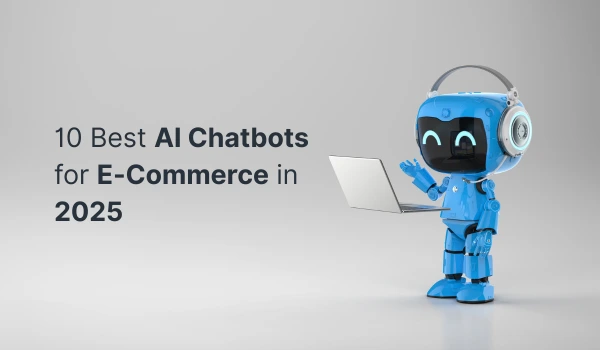TL;DR
The return on investment (ROI) for AI voice agents in enterprise communications is the net financial gain, calculated by subtracting total costs and then dividing by those costs. A well-scoped deployment targets a one-quarter payback (≈approximately 60–90 days), driven by cost per call reduction, Average handle time (AHT) drop, First Contact Resolution (FCR) lift, agent productivity boost, and CSAT gains.
Focus on high-volume, repeatable tasks first- call center automation, inbound support triage, pre-sales qualification, order status, and collections. Use a simple model that totals benefits (cost savings and revenue impact) and compares them to the total cost of ownership (platform, minutes, integration and onboarding costs, QA, and ops).
Introduction
Boards approve AI voice agents for enterprise when the ROI of voice AI is clear in dollars and days. This guide explains the AI voice agent ROI equation, the inputs that matter, and the levers to control. It shows how to set targets for call handling time, First Contact Resolution (FCR), CSAT, and cost per call, and how to map those targets to a practical payback period.
It covers the total cost of ownership (TCO), hidden costs of AI deployment, and pilot vs full deployment steps that keep values on track. Start with the calculator (formula) in Section 2 to measure voice AI ROI in your organization. Then move through pilot vs full deployment steps that protect value.
When ready, book a demo to validate numbers with your data.
What Is the ROI of AI Voice Agents?
AI voice bots are software agents that understand speech, decide next steps, and act across phone, WhatsApp, and web. Many labels exist, like voice AI, conversational AI agents, virtual voice assistants, and voice-enabled agents, but the goal is the same: to resolve tasks with speed, accuracy, and consistency. In the enterprise, these agents plug into CRMs, ticketing tools, and knowledge bases to deliver outcomes at scale.
AI voice agent ROI measures financial return after costs. It is driven by cost per call reduction, Average handle time (AHT) drop, First Contact Resolution (FCR) lift, agent productivity, and CSAT gains. It improves as volumes rise, use cases mature, and handoffs shrink. For enterprise voice AI ROI, count all costs: platform fees, minutes, integration and onboarding costs, QA, and operations, and compare them to savings and revenue impact.
ROI Formula & Methodology
Core model:ROI = (Annual Benefits − Annual Costs) ÷ Annual Costs. Use it to compare AI voice agent ROI outcomes across teams and time. Standardize reporting with must-track AI call metrics and formulas for your dashboard.
- Cost per call reduction from self-service and better routing.
- Fewer transfers from accurate intent detection
- Average handle time (AHT) ↓ through data prefetch and guided flow
- First Contact Resolution (FCR) ↑ from knowledge retrieval and policy checks.
- Agent productivity boost by removing repetitive work.
- Revenue assistance from upsell or retention saves
- Avoided hiring and lower overtime.
Costs total cost of ownership (TCO) to include
- Voice AI pricing and licenses or usage
- Integration and onboarding costs for CRM, CCaaS, and ticketing
- Data/telephony minutes and carrier fees
- Speech-to-text + voice applications and orchestration
- Monitoring, analytics, and observability
- Hidden costs of AI deployment, such as change management, QA, and tuning
Quick numeric example
Inputs: 20,000 calls/month, current cost per call = $3, target deflection = 25%, average handle time (AHT) improves from 6.0 to 4.5 minutes on handled calls. Platform and usage = $12,000/month.
Monthly benefits
- Deflected calls: 5,000 × $3 = $15,000 saved
- Average handle time (AHT) savings on remaining 15,000 calls: 1.5 min × $0.40/min burden = $9,000 saved
- Avoided hiring: 1 FTE equivalent = $5,000 per month
Total benefits = $29,000
Monthly net = $29,000 − $12,000 = $17,000
Annualize: Annual Benefits = $348,000; Annual Costs = $144,000
ROI of voice AI = (348,000 − 144,000) ÷ 144,000 = 141.7%
Payback period: If one-time onboarding is $30,000, payback ≈ 1.8 months ($30,000 ÷ $17,000)
This methodology scales for enterprise voice AI ROI across inbound, outbound, and IVR augmentation. Keep the calculator inputs simple and auditable.
Cost Structure: From Pilot to Full Deployment
A sound rollout follows four stages.
Discovery maps intents, volumes, and baseline costs. POCs validate accuracy and handoffs on a narrow flow. Limited use cases expand to one or two high-volume intents to confirm voice AI pricing and ROI. Phased rollouts scale across regions, queues, and hours with clear KPIs and guardrails. Add a checkpoint after each phase to compare results against your enterprise communications with the AI voice automation’s ROI target.
Core cost buckets; total cost of ownership (TCO)
- Platform (voice agent platforms): Licenses, usage tiers, concurrency, multi-region
- STT/TTS: Automatic speech recognition and synthesis minutes, custom voices, latency SLA surcharges
- Telephony minutes: Carrier fees, call recording, storage, and regional surcharges
- Orchestration: Workflow runtime, function calls, prompt ops, evaluation runs
- Analytics: Dashboards, transcripts, QA scoring, exports, storage
- Security/compliance: Encryption, audit logs, PII masking, data residency, certifications
Integration and onboarding costs include connectors for CRM/CCaaS, ticketing, and the knowledge base. Budget for authentication setup, field mapping, webhook endpoints, and sandbox testing. Add content ops for FAQ cleanup, intent labeling, and policy wording.
Plan for agent training, change management, and supervisor tooling for live monitoring and warm transfer. These one-time tasks keep AI voice agents' cost vs benefit accurate by reducing rework during scale.
To manage voice AI pricing and ROI, lock a pilot envelope (traffic caps, intents, hours) and track deflection, Average handle time (AHT), First Contact Resolution (FCR), CSAT, and cost per resolved call. Approve expansion only when pilot KPIs beat the human baseline and projected enterprise voice AI ROI. Revisit the total cost of ownership (TCO) quarterly as volumes shift.
Benefit Drivers That Move ROI
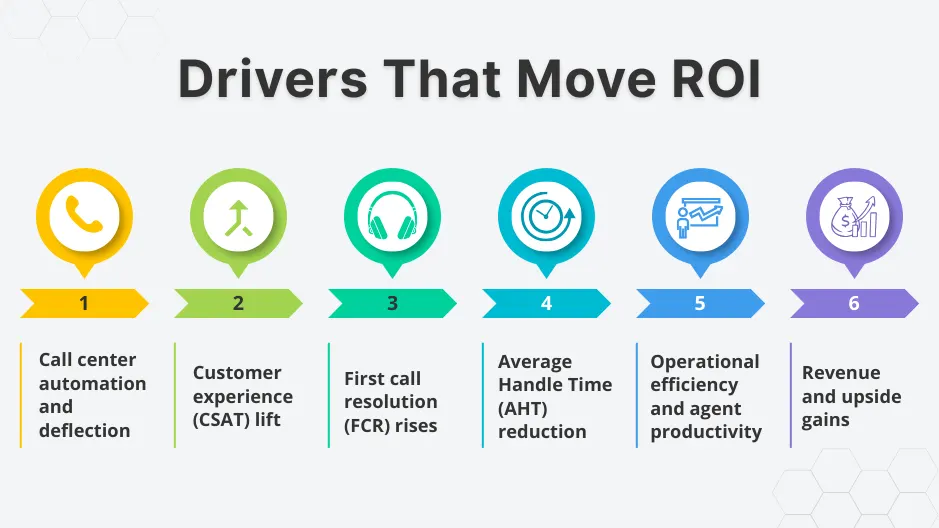
- Call center automation and deflection - Build self-service workflows for high-volume intents. Deflect routine calls to virtual voice assistants that authenticate, fetch data, and resolve outcomes. You get cost savings from conversational voice agents in call center operations by cutting live minutes and reducing queue load.
- Average Handle Time (AHT) reduction - Lower AHT by data prefetch (CRM, orders, policies) and intent accuracy that removes repeats. Summaries flow into the ticket so agents avoid wrap-up time. This shrinks billable minutes and improves the voice assistant’s ROI in the enterprise.
- First call resolution (FCR) - Route by intent and skill, pull answers from a governed knowledge base and policy APIs. With intelligent routing and retrieval, FCR rises while transfers fall, which improves experience and cost per resolved call.
- Customer experience (CSAT) lift - Instant response, consistent tone, and clear next steps raise CSAT. Structured dialogs reduce dead ends and set expectations on handoff. Better CSAT supports retention and revenue protection.
- Operational efficiency and agent productivity - Agents stop repeating Identity Verification (IDV), data lookups, and note-taking. The system handles summaries, dispositions, and follow-ups. That creates a measurable agent productivity boost and frees teams for complex work.
- Revenue and upside gains - 24/7 availability captures sales that arrive after hours. Voice agents book appointments, quote policies, and take payments. Conversational flows use CRM context to suggest cross-sell or retention offers without pressure.
Why do these drivers compound?
Each driver hits the ROI of voice AI with lower unit cost and higher value per interaction. As models learn and coverage grows, deflection, Average handle time (AHT), First Contact Resolution (FCR), CSAT, and staffing plans all improve together. That is how enterprises sustain enterprise voice AI ROI beyond the pilot.
High-ROI Use Cases
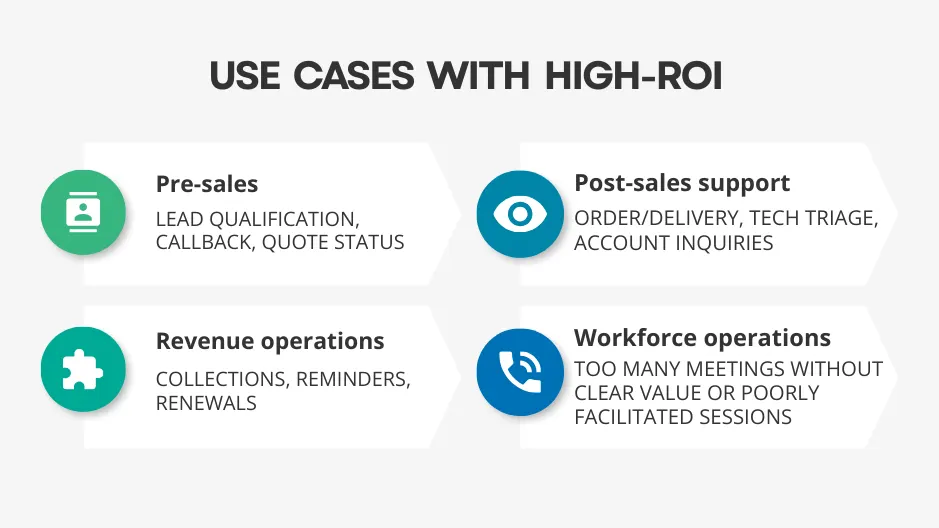
Pre-sales (lead qualification, callback, quote status).
- Flows: Intent-based lead qualification, instant callbacks, quote or policy status, and pre-appointment screening
- Benefits: Higher speed-to-lead, Average handle time (AHT) reduction on discovery calls, cleaner pipeline data, fewer no-shows
- ROI lever: More qualified conversations per hour and recovered after-hours leads drive AI voice agent ROI beyond pure cost cuts
Post-sales support (order/delivery, tech triage, account inquiries).
- Flows: Order status, delivery updates, RMA/returns, password unlock guidance, simple troubleshooting, plan or balance checks
- Benefits: Deflection of repetitive calls, Average handle time (AHT) drop via data prefetch, First Contact Resolution (FCR) lift from guided steps, consistent CSAT
- ROI lever: Fewer live minutes and higher containment improve the ROI of AI voice agents and unit economics
Revenue operations (collections, reminders, renewals).
- Flows: Payment reminders, due-date negotiation, policy or subscription renewals, dunning follow-ups with secure pay links
- Benefits: Higher contact rates after hours, reduced churn, lower days-sales-outstanding.
- ROI lever: Direct cash recovery plus reduced agent load accelerates enterprise voice AI ROI
Workforce operations (appointment scheduling, password/account reset).
- Flows: Book/reschedule/cancel appointments, wait-list offers, one-time passcode verification, account unlock, and profile updates
- Benefits: Fewer back-office touches, faster cycle time, fewer escalations; agents focus on complex cases
- ROI lever: Time saved across teams shows up as productivity and SLA wins that compound over months
Measurement Plan: Metrics, Baselines, and Dashboards
1) Set baselines (4 weeks)
Capture four weeks of data before launch. Lock data sources and IDs so every chart reads from one truth. This anchors your virtual voice agent ROI comparisons.
2) Track three levels
- Operational: Average Handle Time (AHT), First Contact Resolution (FCR), deflection, containment, transfer rate
- Experience: CSAT, abandonment rate, post-call NPS/CES (if used)
- Financial: Cost per call reduction, calls per agent per hour, conversion/revenue for sales or collections
3) Run a tight cadence
Hold weekly pilot readouts with intent-level deltas versus baseline. Update prompts, routing, and knowledge based on findings. Hold a monthly ROI review with finance that rolls savings, revenue assist, and platform usage into a single ROI of voice AI figure. Add in-product notes for every change.
4) Design the dashboard
- Page 1 (KPI tiles): Average handle time (AHT), First Contact Resolution (FCR), CSAT, containment, cost per call
- Page 2 (Funnel): Reach → handled by AI → contained → human handoff → resolved
- Page 3 (Savings & ROI): ROI of voice automation by use case
- Page 4 (Quality): Flags, escalations, and pinned alerts when KPIs drift beyond bands
5) Close the loop
Publish a one-page monthly summary with enterprise voice AI ROI, key wins, and next experiments. Add links to the calculator, analytics dashboard, and change log so stakeholders can verify results.
Risks, Hidden Costs, and How to Avoid Value Leakage
Hidden cost of AI deployment
- Data quality issues inflate handling time and erode AI voice agent ROI. Policy and compliance work adds scope: consent capture, audit logs, retention, and PII masking.
- Multilingual coverage needs ASR/TTS quality, domain terms, and locale testing. Edge cases create rework when intents are missing.
- Change management requires training, new SOPs, and supervisor tooling. Track these items in the total cost of ownership (TCO) so the ROI of voice AI stays accurate.
Common failure modes
- Poor knowledge base: Outdated answers, missing policies, and weak retrieval lower First Contact Resolution (FCR) and CSAT.
- Mis-routing: Brittle rules or weak intent models spike transfers and abandonment rates
- Over-automation: Forcing containment where empathy is needed drives complaints and churn.
- Integration gaps: Broken CRM or ticketing sync blocks resolutions and hides savings.
Mitigations that protect enterprise voice AI ROI
- Tight KPIs: Set bands for Average handle time (AHT), First Contact Resolution (FCR), containment, CSAT, and cost per call reduction; pause expansion when a band breaks.
- Human-handoff by design: Warm transfer with context to specialists for high-risk or emotional scenarios.
- QA loop: Score 100% of calls with policy, safety, and accuracy tags; sample and coach weekly.
- A/B tests: Compare prompts, routing, and knowledge snippets before global rollouts.
- Pilot vs full deployment guardrails: Cap traffic, restrict intents, and run weekly ROI reviews before scale.
- Data-drift watch: Track ASR accuracy, intent hit rate, and fallback reasons; refresh models and content when drift rises.
Outcome
These controls keep value from leaking into rework, refunds, and escalations. They also make savings auditable, so finance can trust the enterprise communications with the AI voice agent’s ROI you report each month.
Conclusion
Voice AI is now an operational system, not a lab project. You win by starting with high-volume intents, measuring AHT, FCR, CSAT, containment, and cost per call, then expanding only when the ROI of AI voice agents beats your baseline. Keep the TCO honest, watch data drift, and use guardrails like warm transfer and A/B tests to protect experience. With the right plan, a 60–90 day payback is achievable and repeatable.
Result: Faster break-even, clearer business case, and cleaner scale across support, sales, and collections.
See it live: Book a demo
FAQs
What is the total cost of ownership (TCO) of a voice AI solution?
TCO includes licenses, usage minutes, STT/TTS, telephony, storage, integrations, monitoring, analytics, QA, and change management. One-time setup spans authentication, field mapping, webhook endpoints, and knowledge cleanup. Review TCO quarterly as volumes and coverage expand.
What use cases of AI voice agents yield the highest ROI?
Top performers include order status, authentication, password/account reset, payment reminders, renewals, lead qualification, and policy or quote status. These flows feature clear data calls and repeatable logic, enabling high containment and short handle times. Start here to prove payback quickly.
How do AI voice agents compare to human agents in ROI?
Voice agents excel in repetitive tasks, 24/7 coverage, and consistent policy adherence. Humans excel at nuanced, emotional issues. The best ROI comes from a hybrid: automate predictable flows, and warm transfer complex cases with full context. This model raises FCR and CSAT while lowering unit cost.
What metrics should be tracked to measure ROI?
Track three layers
Operational: AHT, FCR, deflection, containment, transfer rate.
Experience: CSAT, abandon, post-call NPS/CES.
Financial: cost per call reduction, calls per agent per hour, conversion, or recovered revenue.
Use weekly pilot readouts and a monthly ROI roll-up with finance.
What are the hidden costs of AI voice agent implementation?
Hidden items include data cleanup, consent and audit logging, PII masking, multilingual testing, edge-case design, change management, and supervisor tooling. Budget these in TCO to keep ROI accurate. Track setup tasks like authentication, field mapping, and KB hygiene to avoid rework.
Can AI voice agents improve customer satisfaction (CSAT)
Yes, with instant response, consistent information, and clear next steps, CSAT is raised. Intelligent routing plus knowledge retrieval improves first-contact resolution. Warm transfer protects sensitive conversations. Monitor CSAT alongside abandonment rate and resolution time to ensure quality scales with automation.
What cost savings can AI voice agents deliver in a call center?
Savings come from fewer live minutes, reduced transfers, shorter handle time, and avoided hiring. Deflecting routine calls and automating wrap-up lowers unit cost per interaction. Teams also save on training and overtime. Track cost per call, containment, and calls per agent per hour to quantify impact.
How long does it take to break even on an AI voice agent investment?
Well-scoped rollouts typically reach break-even in 60–90 days. Faster when you start with high-volume intents like order status, authentication, and collections. Timeline depends on deflection rate, AHT, and FCR improvements, and implementation expenses. Use a pilot envelope and expand only when KPIs beat human benchmarks.
How do you calculate voice AI ROI / formula?
Use ROI = (Annual Benefits − Annual Costs) ÷ Annual Costs
Benefits include savings from deflection, faster handle time, fewer transfers, avoided hiring, and revenue assistance from renewals or upsell. Costs include platform pricing, minutes, STT/TTS, integrations, monitoring, and change management.
What is the ROI of deploying an AI voice agent in enterprise communications?
ROI is the net financial gain divided by total costs.
Programs lift returns through cost per call reduction, lower AHT, higher FCR, agent productivity, and CSAT gains. Measure savings and revenue against the total cost of ownership (licenses, minutes, integrations, QA, ops).





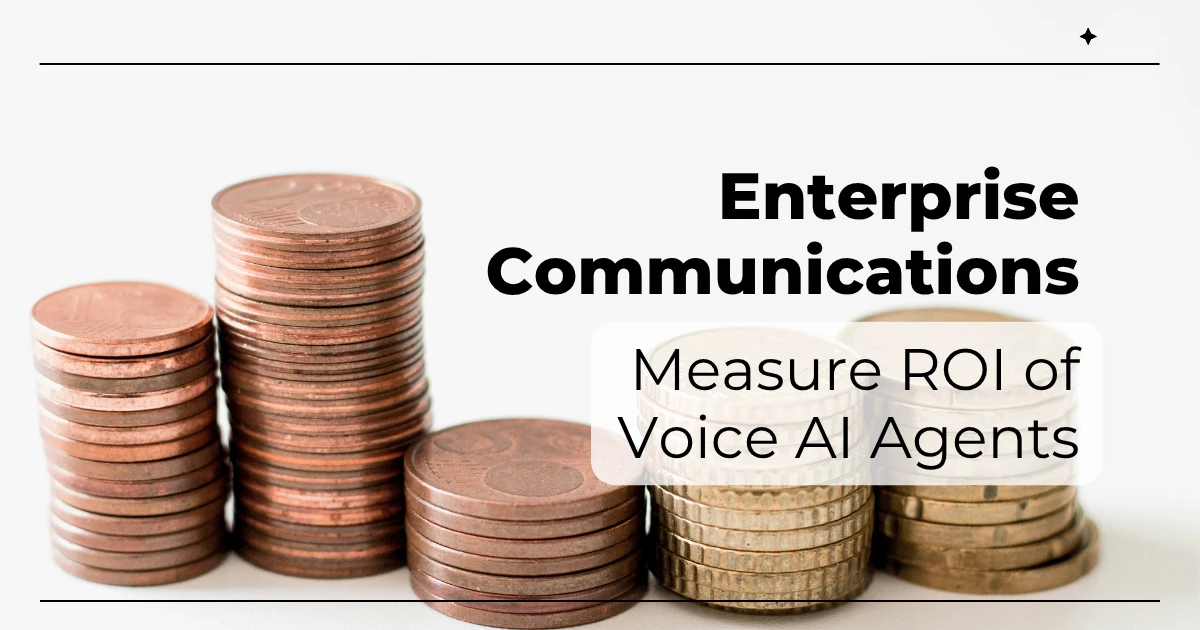
.webp)
.png)


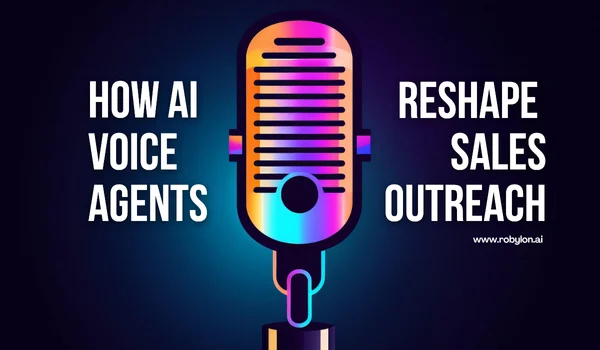
.webp)

